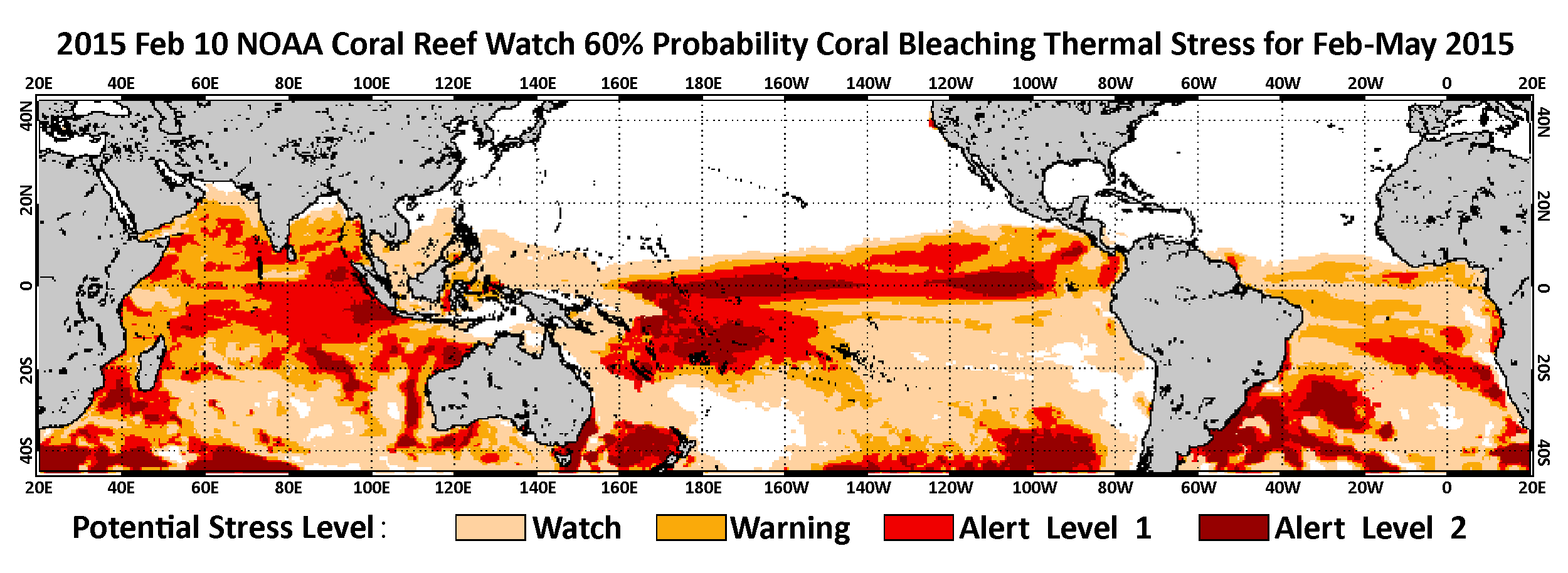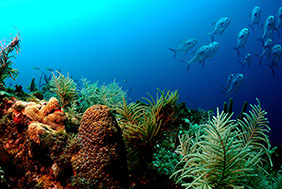-
Home
-
Data & Publications
-
Regional Portals
- About Regional Portals
- Florida
- Navassa Island
- Puerto Rico
- Flower Garden Banks
- U.S. Virgin Islands
- American Samoa
- Commonwealth of the Northern Mariana Islands
- Federated States of Micronesia
- Guam
- Main Hawaiian Islands
- Republic of the Marshall Islands
- Northwestern Hawaiian Islands
- Republic of Palau
- Pacific Remote Island Areas
-
CRCP Activities
- Glossary
Improvements to NOAA Coral Reef Watch's near-real-time satellite monitoring and modeled predictions of coral bleaching thermal stress globally and regionally

NOAA Coral Reef Watch has just released new products on its website. These are:
- Full global and regional implementation of our new daily 5-km satellite coral bleaching thermal stress product suite, which replaces our heritage 50-km product suite. (Access to our 50-km products will continue for the next several months); and
- Version 3 of our weekly-updated Four-Month Coral Bleaching Thermal Stress Outlook, now at 50-km resolution, replacing version 2 of the Outlook.
5-km Global Products:
Noticeable to the users will be the increased spatial (5 km) and temporal (daily) resolutions of the products and some adjustments to our color scales . Less noticeable, but just as important, the new products use a next-generation satellite SST data set and a new climatology. Changes to the color scales have been made to provide better identification of values by those with limited color vision, to enhance the transitions at significant value intervals, and to accommodate higher thermal stress values that we unfortunately now need. These products are now available at the Coral Reef Watch home page.
5-km Regional Products:
The 5-km product selectors on the home page and side navigation bar now point to a new system that provides access to coral bleaching thermal stress data for all reefs worldwide. The new Regional Virtual Station system can be accessed from different pages on the Coral Reef Watch website, including Google Maps interface and via our new Google Earth file. The file will need to be downloaded as a new kmz at https://coralreefwatch.noaa.gov/product/ge/index.php to run the 5-km products in Google Earth. In the future, the existing and new Google Earth files will be merged into a single kmz file.
The Regional Virtual Stations represent a change from the way Virtual Station data has been looked at in the past. They have been designed to take advantage of higher resolution data while simultaneously providing comprehensive information on all reefs in a jurisdiction or sub-region. We realized early on that data from a single 5-km pixel (satellite data grip point) provide much higher spatial detail but are less representative of a region⁏s thermal conditions, especially certain regions that now containing hundreds to thousands of 5-km pixels. Additionally, many managers wanted to know what was happening across their entire jurisdiction. Rather than constructing Virtual Stations based on single 5-km pixels as we did in our heritage 50-km Virtual Stations, we created Regional Virtual Stations based on data from all of the 5-km grids within an individual jurisdiction (e.g., Main Hawaiian Islands). The bleaching thermal stress outlook was also added for the coming 1-4, 5-8, and 9-12 week periods to the new Virtual Stations/Gauges to help managers better prepare for potential coral bleaching events.
An alert for a region is meant to inform users that they should look at the map products for more detail. These Regional Virtual Stations will be used in a series of our products including
- Regional Gauges
- Two-year time series graphics
- Multi-year time series graphics
- Virtual Stations map with data overlays in a Google Maps interface
- Virtual Stations map with data overlays in a Google Earth file
- Email Bleaching Alerts (one alert per region, sent out twice-weekly, free to subscribers) − coming soon
However, we realize our approach has its costs as well. Some of the pros and cons we have identified in this switch are:
Pros of Regional Virtual Stations:
- Utilization of higher resolution data
- Quick guidance for an entire jurisdiction or sub-region
- Better sense of regional impacts
Cons of Regional Virtual Stations:
- Lower geographic specificity for individual islands and reefs
- Less information on patterns within jurisdictions or sub-regions
As the alerts are meant to draw users to the maps, we think this will still provide the spatial pattern of the thermal stress − now at 5-km resolution.
For now, our Satellite Bleaching Alert emails will remain tied to our 50-km products. Very soon we will be converting this system to our 5-km data and will convert users’ subscriptions to match the new Regional Virtual Stations. If you are not yet signed up for this system, you can still do so on the old system at http://coralreefwatch-satops.noaa.gov/VS/virtual_station_alerts.html.
We also have expanded the geographic network to include all coral reefs around the world based on available references. These included the Millennium Coral Reef project maps, the IUCN Coral Reefs of the World three-volume set, the UNEP/WCMC World Atlas of Coral Reefs, several country scale atlas publications, and a few other resources. If we have missed a coral reef that you know of, please let us know the name and coordinates of the missing reef.
We do plan to produce an extensive set of Virtual Stations to represent single reefs using one to a few 5-km pixels. This is a major undertaking that we are planning as a next phase of our implementation. However, this list of over a thousand virtual stations will be rather unwieldy for many users. We also may provide products that allow users to better query individual or groups of pixels. For now, that is best done using the netCDF files we have made available for all of our 5-km products. These will be fully compatible with the NOAA CoastWatch Data Analysis Tool (CDAT) available from our website, ArcGIS, and many other tools.
Four-Month Coral Bleaching Thermal Stress Outlook, Version 3:
This update to our Bleaching Outlook features three changes, which should be fairly transparent to users. Version 3 is based on NOAA/NCEP’s latest Climate Forecast System (CFS) Version 2 (CFSv2), continues to be updated every Tuesday, and now features 50x50 km (0.5°x0.5°) resolution. Version 3 of our Bleaching Outlook also replaces earlier versions of the Outlook on our Google Maps interface and our existing Google Earth file.


